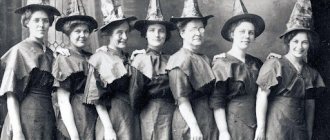Summary of entertainment on the topic: “Checkers tournament”
Goal: to create conditions for the intellectual development of preschool children.
Tasks:
- Activate mental activity, train memory, attention, resourcefulness, ingenuity;
- Develop logical thinking, a sense of responsibility and the ability to resolve problem situations;
- Cultivate calmness and perseverance, the ability to win with dignity and lose with dignity.
Preliminary work:
- Learn poems about the rules of the game in advance
- Prepare diplomas and cards with the names of tournament participants;
- Prepare musical accompaniment for the tournament, decorate the hall, prepare tables for the event.
Tournament rules:
All participants play in the first round (8 children - 4 pairs)
tournament.
Observers watch the progress of the game. The players who lost in the first round (4 people)
take 3rd place and leave the game.
In the second round, the winners of the first round (4 people)
and divide the 1st and 2nd places among themselves
(two first and two second places)
. Between rounds there is a musical movement warm-up.
Opening of the tournament:
To the accompaniment of music, children walk around the hall and sit on chairs.
Presenter
1
: Hello, dear guys and guests. Today is a significant day in our kindergarten - today our children are participating in a checkers tournament.
Checkers is one of the most ancient games. It is known that the first checkers appeared in Ancient Egypt. From there, this game began its journey throughout the world. They came to Russia in the 10th century and firmly entered the life of our people. This game was so exciting that it is still played to this day.
Currently, this game has become one of the sports. Our children learned the basics of the brilliant game of checkers, and we hope that they will carry their love for this game throughout their lives.
Carlson runs in to the accompaniment of music, shouting “Wait, don’t start without me!” He has a checkerboard under his arm.
Carlson:
Hello, dear friends! Please tell me, is there a checkers tournament taking place here?
Presenter 2:
Hello Carlson. You weren't wrong. It is in our garden that a checkers tournament for young checkers players takes place.
Carlson:
Have you come to compete?
Compete in Russian checkers?
Guys, I also love to play checkers and I know all the rules of this game. Do you know the rules of the game of Russian checkers well?
Children:
Yes.
Carlson:
This is why I praise you.
But before you start the game
I want to test everyone
Find out your knowledge!
Rules of the Russian game of checkers
1) You can start the battle with confidence - White always makes the first move!
2) Checkers slowly but accurately walk only
on black squares!
3) Probably the checkers are unlucky, That the checkers only move
FORWARD!
4) Everyone knows: both old and young, We hit with a checker
forward and back!
5) The opponent’s checker will immediately die if yours
jumps over it!
6) The field will suddenly end, the checker will immediately
become a “king”!
7) So that your “queen” is not caught, move it along the entire
diagonal! The goal of the game is to beat the “enemies” and so that they have no
The goal of the game is to beat the “enemies” and so that they have no
moves!
Carlson:
Until I torment you any longer, the time has come to invite players and to determine the pairs of players
Draw (conducted by Carlson).
He invites participants to the table where cards with numbers are laid out. Children choose numbers and thereby determine their pair and table number.
Leading:
So, our participants have chosen pairs and now we give the floor to them.
Well, as usual in every game, the Jury will help you fight completely!
Presenter (addresses the players) :
— Do not break the rules of the game, be calm and extremely attentive and success awaits you!
-I declare the checkers tournament open!
The tournament begins. Observers keep a record of the competition to identify the winners.
At the end of the tournament, the winners of the tournament are determined.
Referee: The referee announces the criteria for evaluating the game:
1) a tournament participant plays 2 games (one with white, the other with black);
2) the winner of the tournament is the checkers player who scores the most points;
3) one point is added to the tournament table for winning a game, half a point for a draw, and zero for a loser. Good luck!
(Russian anthem plays)
The tournament participants take their tables and begin to play. The game is monitored by referees assigned to each table. At the end of the game, the referees evaluate the game.
The judge fills out the results table located on the magnetic easel and determines the winners. The winners are paired for the next stage of the tournament. The tournament lasts until the leaders for 1st, 2nd, and 3rd places are identified. Tournament duration is 60 minutes.
The conclusion of the checkers tournament is announced by the chief judge. Carlson takes part in awarding the participants and presenting diplomas and valuable prizes.
Carlson:
Well, it's time for me to say goodbye.
I will come to you again as soon as there is a checkers tournament in your kindergarten. Goodbye, guys! (they leave the hall to the music)
Presenter 1:
Our checkers holiday has come to an end. You fought bravely to win the tournament, unfortunately not everyone was lucky enough to win today.
Presenter 2:
Thanks to all those who participated in our tournament, thanks to the fans and guests for supporting the players, we think that holding a checkers tournament will firmly become part of the traditions of our kindergarten. The time will come and we will gather again, we will fight and win!
Leading:
At this point, I declare the checkers tournament closed. See you again!
Progress of the lesson
Organizational stage. Motivation
Teacher: Hello, guys. You are candidates for the school checkers team. Today this event will reveal which of you will make it to the main team of the school team, and which will become a reserve athlete.
Today we have 2 teams - “Checkers Players” and “Checkers Players”. And you have to conduct an intellectual battle to determine the best of equals.
And our experts Andrey and Alexey, who have the first youth level in checkers, will evaluate your work.
Goal setting. Technique “Speculation”
Teacher: Today we have a lesson, the topic of which you will give yourself using words - hints on the board (over, checkers, conditions, king, victory).
Hint: the first word is “Conditions” (children answer).
So, the topic of our lesson is: “Conditions for the victory of checkers over the king”
You already know that queens are stronger than checkers. Do you want to learn how to defeat your opponent's king with your checkers, or how to break a game in which your opponent has two kings and you only have checkers? (WANT!)
Okay, then name the purpose of our lesson, using one of the helping words (on the board): “Repeat”, “Study”, “Let’s find out”, “Check”.
So, what is the purpose of our lesson? (3-4 people say their goal)
And our common goal is to study the conditions under which checkers are stronger than kings.
Updating knowledge
Intellectual warm-up questions for teams taking turns: 3 sec. - to the answer.
- Is it necessary to capture other people's checkers and kings? (Yes).
- Is it possible that none of the players will win the game? (Yes).
- What is the longest diagonal "a - h" called? (“Big Road”)
- What are the names of the diagonals “b - 2” and “g - 7” and connecting them? ("Double").
- What are the names of the diagonals “c – 6” and “f – 3” and connecting them? ("Tee").
- What are the parallel diagonals “b - 7” and “g - 2” called? (“Doppelganger”).
- What are the parallel diagonals “c – 3” and “f – 6” called? (“Threesome”).
- What are the parallel diagonals “5 – d” and “e – 4” called? (“Job”).
- What is the advantage? (Material and positional)
- Which advantage is more beneficial? (Positional)
The task “True or false?”
Answer “True” or “False” to the following statement:
- The queen will always defeat one checker (No).
- The queen will always win 2 checkers (No).
- 4 queens will always beat 1 queen (Yes).
- 3 queens will always beat 1 queen (No).
- 2 queens will always beat 1 queen (No).
- 3 checkers standing in front of the “high road” can lead to a draw (Yes).
- 4 queens will always beat 2 queens (No).
- A queen standing on the “high road” will not lose to two queens (Yes).
- A queen standing on the “high road” will not lose to three queens (Yes).
- The checker always helps his queen (No).
Main stage (new topic)
Working with the text “Extract from the rules of the game of Russian checkers” (“Insert” technique) -5 min.
Teacher:
Raise your hand those who put a “–” sign in the text. And now those who have the “+” sign. And those who have the “?” icon.
Okay, so you worked with the text carefully, which we will check now.
2 questions for teams on the content of the text (for evaluation by experts):
- Can one participant propose a draw more than once? (Yes)
- Is it possible to correct a checker during an opponent's move? (No)
- Is it possible to move a checker or king across the same square several times? (Yes)
- Is it possible to achieve a draw in five moves? (Yes)
Explanation and demonstration of the solution to a checkers problem with a positional advantage in simple checkers versus kings.
Teacher: White and black each have 5 pieces. Who has the material advantage? (Black has 2 queens and 3 checkers versus White’s 5 checkers).
Can White use the position to his advantage? (They can, with the only correct move f 2 on e3, forcing the black king to capture the white checker, and the white checker g 3 will capture all the black pieces.)
Methodological development of a lesson on checkers “Checkers notation and recording of games”
Instructions for distance learning in off-line mode
Educational program “Russian Checkers”, year 1
Topic of the lesson: “checkers notation and notation of games”
Good afternoon guys!
The topic of our lesson is “checkers notation and notation of games”
ABC of checkers
The initial arrangement of Russian checkers is shown in Diagram 1, with the black corner square of the large diagonal should be to the left of each opponent. Diagram 1 - starting position
| a | b | c | d | e | f | g | h |
| 8 | O | O | O | O | |||
| 7 | O | O | O | O | |||
| 6 | O | O | O | O | |||
| 5 | |||||||
| 4 | |||||||
| 3 | O | O | O | O | |||
| 2 | O | O | O | O | |||
| 1 | O | O | O | O |
Position - a specific arrangement of white and black checkers on the board, as well as a checkers game is written using checkers notation, consisting of eight numbers 1, 2, 3, 4, 5, 6, 7, 8 - indicating the numbers of the ranks, and eight Latin letters alphabet a, b, c, d, e, f, g, h - indicating verticals. Notation - there is an alphanumeric system for designating board fields for recording the position of checkers and moves. The fields are taken as the intersection points of verticals and horizontals. For example, the starting position in diagram 1 is written as follows:
white: a1, a3, b2, c1, c3, d2, e1, e3, f2, g1, g3, h2 (12) black: a7, b6, b8, c7, d6, d8, e7, f6, f8, g7, h6, h8 (12) White move
This entry replaces diagram 1. In this case, say, checker c3 is at the intersection of the vertical “c” and the third horizontal, checker f6 is at the intersection of the vertical “f” and the sixth horizontal, etc. So, when writing a position, the notation indicates the location of the forces of White and Black, in brackets the number of checkers and then the order of moves. Diagram 2 shows the designation of all the black squares on the checkerboard. Diagram 2
| 8 | b8 | d8 | f8 | h8 | |||
| 7 | a7 | c7 | e7 | g7 | |||
| 6 | b6 | d6 | f6 | h6 | |||
| 5 | a5 | c5 | e5 | g5 | |||
| 4 | b4 | d4 | f4 | h4 | |||
| 3 | a3 | c3 | e3 | g3 | |||
| 2 | b2 | d2 | f2 | h2 | |||
| 1 | a1 | c1 | e1 | g1 | |||
| a | b | c | d | e | f | g | h |
To record the move of a simple checker or king, first write down the serial number of the move, then the designation of the field on which the checker or king stood, then put a dash and sign the designation of the field on which it was placed. For example, the entry 1) c3-b4 f6-g5 means that White's move c3-b4 and Black's counter move f6-g5 are recorded, which is considered one move in the game. If a capture occurs, i.e. shock move, in contrast to the usual quiet move, then a colon is placed instead of a dash. Let's say the entry 7) a3:c5 means: 7 is the sequence number of the move; a3 - the field from which the move was made; (:) - a colon instead of a dash means that a battle has taken place, i.e. shock stroke; (-) - means a quiet move, without a fight; c5 is the square on which the move ends. The entry 8)...f6-e5 means that Black's eighth move is written (three dots after the sequence number of the move). The following popular notations are also used: = - draw; X - height; ! - good, strong move; !! - very strong, difficult to find move; ? - bad or weak movement; ?? - very bad, losing move; !? - a move whose assessment is unclear. Let's look at a specific example of recording a checkers game. A. Kovrizhkin - Z. Levin Kharkov, 1933 1. g3-f4 f6-e5 2. c3-d4 e5:c3 3. b2:d4 d6-c5 4. d2-c3 g7-f6 5. h2-g3 h8 -g7 6. c1-b2 f6-g5 7. g3-h4 g7-f6 8. f4-e5 f8-g7? Diagram 3
| 8 | O | O | |||||
| 7 | O | O | O | O | |||
| 6 | O | O | O | ||||
| 5 | O | O | O | ||||
| 4 | O | O | |||||
| 3 | O | O | O | ||||
| 2 | O | O | |||||
| 1 | O | O | O | ||||
| a | b | c | d | e | f | g | h |
white: a1, a3, b2, c3, d4, e1, e3, e5, f2, g1, h4 (11) black: a7, b6, b8, c5, c7, d8, e7, f6, g5, g7, h6 ( 11) Black's eighth move loses. Should have played 8…e7-d6 9. e5:g7 f8-e7 10. h4:f6 h6:f8 11. c3-b4 e7:g5 12. b4-a5 d8-e7 13. f2-g3 g5-f4 14. e3 :g5 c5:e3 15. g3-f4 e7-f6 etc. Let us return, however, to the main trend of the party. A system of abbreviated (short) notation is also used. In this case, the field from which a move is made is indicated only by a letter and a dash is omitted, and the field on which a checker is placed as a result of a move made or captured is indicated by a letter and a number. For example, 1)cb4 fg5. The colon indicating a shock move is left, for example, 7)a:c5. It happens that a certain move must be written down in full notation. For example, the various takes 10) a5:c3 and 10) c1:c3 in the abbreviated notation - 20) a:c3 do not differ. The above game in brief notation is written as follows: 1.gf4 fe5 2.cd4 e:c3 3.b:d4 dc5 4.dc3 gf6 5.hg3 hg7 6.cb2 fg5 7.gh4 gf6 8.fe5 fg7? 9.ef4!! g:e3 (If you beat 9...c:e3 10.f:d2 f:d4 11.h:h8X) 10.gh2 e:g1 11.cb4 c:e3 12.ef2 f:d4 13.hg5 h:f4 14 .bc3 d:b2 15.f:d4 g:c5 16.b:c1 , and Black resigned.
Guys, look at this link https://drive.google.com/file/d/11woESutcTNXje496KI-tSGI75G0sgaxr/view?usp=drivesdk
the most important thing is that it will be useful to you in competitions.
D/3
Play the game in full, both for yourself and for the person who will play with you, on a piece of paper, take a photo and send me your recording of the game in a private message. I’ll take it apart, see how it turned out - if anything needs to be done, we’ll correct it.
Thank you for attention.
Resource used https://www.kombinashki.ru/okon_page1.php





